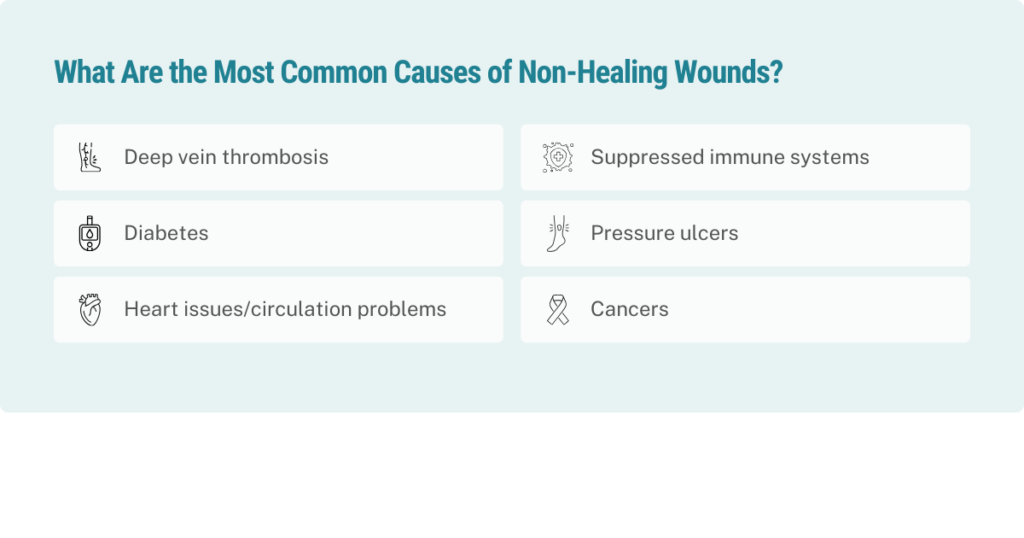5 Ways We Treat Non-Healing Wounds in the Elderly
Did you know that chronic wounds affect about 2.5% of the U.S. population—and older Americans are much more likely to develop non-healing wounds than younger people? As we age, the healing process slows down, which makes diligence so important to treat these non-healing wounds in the elderly before they cause major, more serious problems.
Diabetic foot ulcers, pressure ulcers and venous leg ulcers are some of the most common wounds we see and treat.
At Brook Stone, we understand that chronic health conditions like diabetes, cancer, and poor circulation can slow the healing process in older adults. That’s why our wound care specialists take a proactive, collaborative approach to treating non-healing wounds in the elderly. We work closely with your doctors and healthcare team to promote faster healing and achieve the best possible outcomes.
Does your loved one have a non-healing wound? Do they need a level of care you’re no longer able to provide? Brook Stone is an ideal skilled nursing community in Pollocksville that offers regular activities, comprehensive care, nutritious meals and all levels of physical rehabilitation. Ready to take the next step? Just contact us.
Next, we’ll take a closer look at some of the ways we help our residents recover from problem wounds.
How Are Non-Healing Wounds Treated? 5 Ways We Treat Non-Healing Wounds in the Elderly
1. Antibacterial Treatment
One of the most important elements of treating non-healing wounds is identifying the underlying issue and preventing infection before it spreads. This may require antibiotics and specialized antimicrobial dressings to protect the wound. When an infection is present, careful monitoring of both personal hygiene and the wound itself is crucial to prevent complications and support healing.
In our skilled nursing community we have the resources to help ensure that any wounds are treated in a timely manner in order to avoid complications. At Brook Stone, medical assistance is available 24/7.
2. Advanced Wound Dressings
Wound care technology is continually improving. Instead of “regular” dressings, specialized products can promote healing in a much more effective and efficient manner. Examples include:
- Hydrocolloid dressings, which are made from materials that keep the healing environment moist and insulated.
- Foam dressings
- Alginate dressings, which are known for their absorbency for mounds with heavy drainage.
3. Debridement
This is a minor surgical procedure where dead or infected tissue is removed. This is a vital part of the healing process and can prevent infections from spreading.
Our healthcare professionals have extensive experience debriding wounds, always placing the care and comfort of the patient as top priority.
4. Hyperbaric Oxygen Therapy
If you or your loved one is a suitable candidate, we may recommend hyperbaric oxygen therapy. This treatment involves breathing pure oxygen in a high-pressure hyperbaric chamber, which boosts oxygen levels in the blood and supports faster, more effective healing.
5. Managing Underlying Conditions
If you have an underlying condition such as diabetes or circulation problems, chronic wounds can become a constant issue. By effectively managing these illnesses, we can eliminate or dramatically reduce the number of chronic wounds.
Managing your health is about much more than medication management. It’s also about ensuring you have nutritious and delicious meals from our kitchen, along with adequate hydration. That’s why, at Brook Stone, we take a comprehensive, holistic approach to the healthcare needs of our residents.
What Is Considered a Non-Healing Wound?
Any wound that doesn’t heal within the expected timeframe is considered a non-healing wound. Typically, this is around four to six weeks, although underlying medical conditions may affect this timeline.
Why Are Non-Healing Wounds More Common in the Elderly?
As people age, they are more likely to develop conditions like poor circulation, heart disease, diabetes, and cancer, which can slow the healing process. Additionally, aging affects cells, making it harder for them to divide and regenerate. This leads to thinner skin and reduced fat cell replacement, weakening the skin’s ability to heal properly and defend against bacteria.
What Are the Most Common Causes of Non-Healing Wounds?
Some of the most common causes of non-healing wounds are:

Brook Stone: Monitoring and Treating Non-Healing Wounds in the Elderly
If not treated in a timely manner, non-healing wounds can have catastrophic results. Not only do they devastate someone’s quality of life, but in extreme cases, may even lead to amputation. This is why it’s so vital to get wound care at the first sign of a problem.
We’re committed to providing compassionate, high-quality care for your loved ones, treating them with the respect and dignity they deserve.
Does your loved one need care you can no longer provide? Do you wonder about their health and well-being? We would welcome your loved one to our Brook Stone family. Ready to take the next step? Just contact us.
The content within this article and others on this website is only for educational purposes and should not be considered as medical advice. For any questions or concerns, please consult with your healthcare provider.
====
Sources:
Gould L, Abadir P, Brem H, Carter M, Conner-Kerr T, Davidson J, et. al, Chronic wound repair and healing in older adults: current status and future research. J Am Geriatr Soc. 2015 Mar;63(3):427-38. https://pubmed.ncbi.nlm.nih.gov/25753048/
Mayo Clinic, “Hyperbaric Oxygen Therapy,” https://www.mayoclinic.org/tests-procedures/hyperbaric-oxygen-therapy/about/pac-20394380
Mayo Clinic Health System, “Wound Types and Healing Therapies,” https://www.mayoclinichealthsystem.org/locations/eau-claire/services-and-treatments/wound-and-ostomy-care/wound-types-and-healing-therapies
Mishra, Abhishek, Aniket Kushare, et. al, “Advanced Dressings for Chronic Wound Management,” https://pubs.acs.org/doi/10.1021/acsabm.4c00138
Sen CK. Human Wound and Its Burden: Updated 2020 Compendium of Estimates. Adv Wound Care (New Rochelle). 2021 May;10(5):281-292. https://pmc.ncbi.nlm.nih.gov/articles/PMC8024242/
University of Pittsburgh, “Why do Older People Heal More Slowly?“ https://www.pittwire.pitt.edu/pittwire/features-articles/why-do-older-people-heal-more-slowly#:~:text=The%20replacement%20of%20fat%20cells,time%20healing%20properly%20as%20well.
Yale Medicine, “Non-Healing Wound,” https://www.yalemedicine.org/clinical-keywords/non-healing-wound#:~:text=Definition,system%2C%20or%20underlying%20medical%20conditions.

